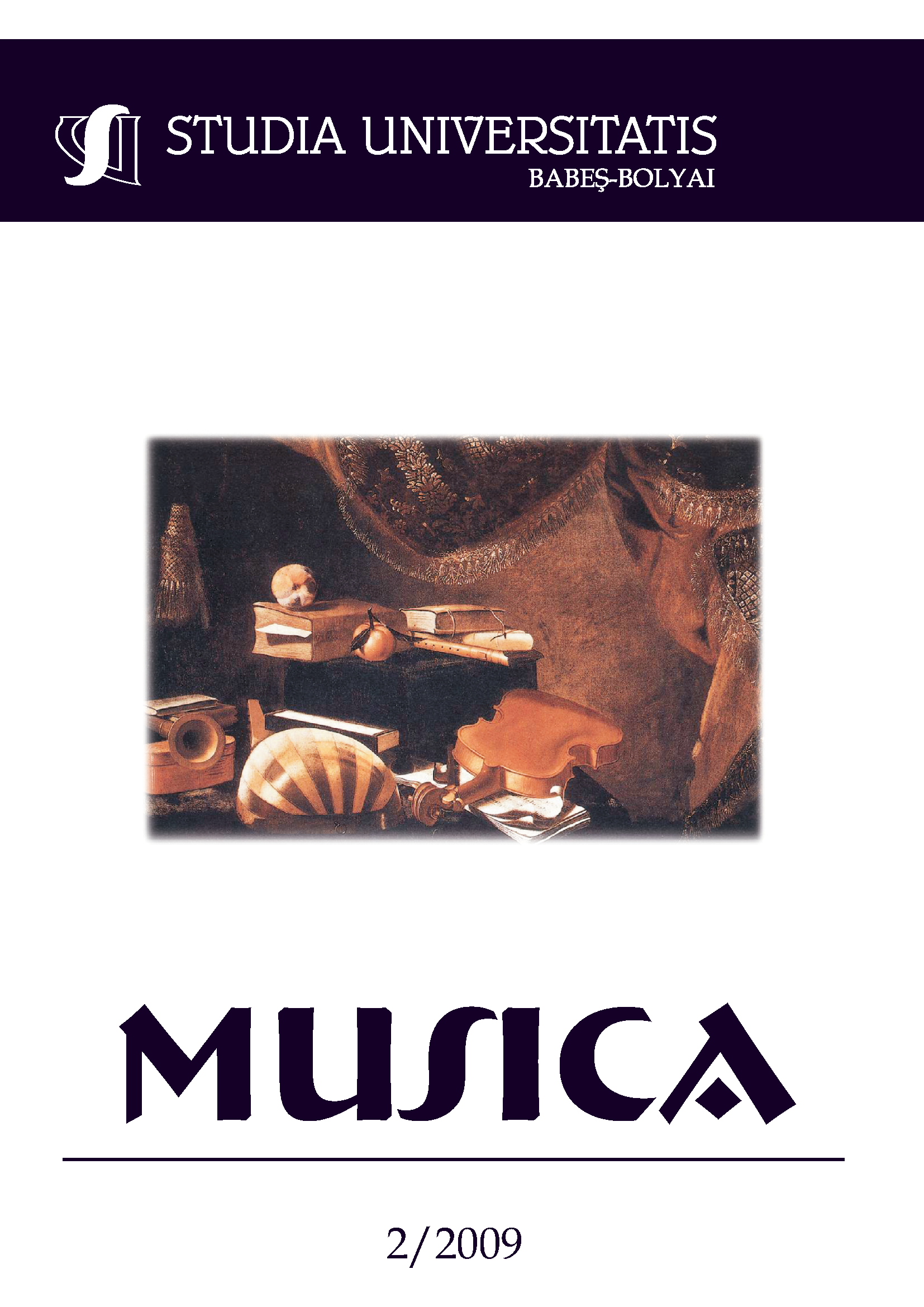“B. A. C. H. - MISSAL FOR ORGAN”, BY EDUARD TERÉNYI
Keywords:
Eduard Terényi, contemporary organ music, instrumental missal, B. A. C. H. motif/pattern, Christ’s passion and death, constructivism in music, mirror symmetryAbstract
B. A. C. H. missal for the organ op. 4 (1967) constitutes the prototype of the creation period of the 62s – 72s that is considered by the maestro Eduard Terényi to be “constructivist” or “the crystal music”, that is characterized through symmetry (melodic lines, chords, mirrored rhythmic reports) and also, the closeness to the serialisation through the application of certain pre-established rhythmical-melodically patterns.
“Not even a tone is free!” the author declares. The entire musical work has a constructive characteristic, which has the key in the anagram B.A.C.H. The generating motif is extrapolated to other levels of articulation: the rhythmical, the harmonically, the formal, the one of the central tones, the dimensions in bars and that of the macro-organisation of the work. Regarding the circularity idea that is suggested by the B.A.C.H. melodic movement, the formal technique is that of a melodic ostinato, either harmonically or polyphonically.
The B. A. C. H. motif is treated as a micro-series as it can be found in all the four hypostases of the modus quaternion, into transpositions of these and also into permutations and transpositions of the permutations. We can remark the composer’s preference for the symmetrical, palindromical structures: the exposing in a vertical mirror (the recurrence) or the horizontal one (the inversion) of two or more motifs of the B. A. C. H. type; the chords in the mirror.
The rhythmic formulae are generated by a unique proportion of 4 - 3 - 2 – 3, that represents the translation in rhythmic duration of the idea of circularity that is contained inside the melodic line of the B. A. C. H. motif. The entire structure of the musical work symbolizes the circularity through the central tones of every part (pedal tone or the pylon) summing up the letters B. A. C. H., the dimension in bars of the sections of the work give the characteristic report to the fundamental rhythmic formulae: 3 - 2 - 3 - 4. The duration in minutes and seconds of the execution of the parts comes closer to the above – mentioned report.
The connotations of the B. A. C. H motif as symbol of the cross (Kreutzmotiv) are extrapolated to the content of affections and ideas of the whole work. The title could have been Passio – maestro Terényi confesses. As it was composed after the author’s meditations that took place on Golgotha, B.A.C.H. - Missal for Organ carries the connotative semantics of an ideated programme that was declared by the author to refer directly to the suffering, the death and the resurrection of the Saviour.
References
Terényi, Eduard, in: The New Grove Dictionary of Music and Musicians, Edited by Stanley Sadie, London, 1992.
New American Standard Bible, Thomas Nelson Publisher, Nashville-Camden - New York, 1977.
Coca, G., Ede Terényi. Retrospectiva a cinci decenii de creaţie (l, II)” (EdeTerényi. The Retrospective of Five Decades of Creation), in: Muzica Review, Bucharest, no. 3/1997 and 4/1997.
Cosma, V., Terényi, Eduard, in: Muzicieni români, compozitori şi muzicologi (Romanian Musicians, Composers and Musicologist), Encyclopaedia, Muzica Publishing House, Bucharest, 1970.
Hotoran, M., Conceptul variaţional în creaţia pentru orgă a lui Ede Terényi (The variational concept in Ede Terényi’s organ music), Risoprint Publishing House, Cluj-Napoca, 2008.
Hotoran, M., The Hymnological, Theological and Cultural Pattern Christus Victor (Christ Triumphant) and its Relevance in Eduard Terényi’s Musical Creation, in: Studii de Imnologie (Hymnologycal Studies), vol. III, The Publishing House of the West University, Timişoara, 2006.
Hotoran, M., Patimile şi moartea Domnului in viziunea componisticii secolului XX. Genul pasiunii (The Dolorous Passion and Death of our Lord Jesus Christ in the Works of the 20th Century Composers. The Passio Musical Genre), Risoprint Publishing House, Cluj-Napoca, 2008.
Molnár, T., Muzica pentru orgă în secolul al XX-lea în România - compoziţii noi, analize stilistice şi interpretative (The Romanian Organ Music in the 20th Century – recent works, analysis of style and interpretation), Grafycolor Publishing House, Cluj-Napoca, 2005.
Sârbu, C., EdeTerényi – Portrait, in: Muzica Review, Bucharest, no 9/1985.
Terényi, E., The Harmony of the Modern Music (1900-1950), Grafycolor Publishing House, Cluj-Napoca, 2006.
Terényi, E., Dantesca, Grafycolor Publishing House, Cluj-Napoca, 2007.
Toduţă, S., Formele muzicale ale Barocului în operele lui J. S. Bach (The forms of the Baroque music in J. S. Bach’s creation), vol. ll, Muzica Publishing House, Bucharest, 1973.
Downloads
Published
How to Cite
Issue
Section
License
Copyright (c) 2009 Studia Universitatis Babeș-Bolyai Musica

This work is licensed under a Creative Commons Attribution-NonCommercial-NoDerivatives 4.0 International License.



